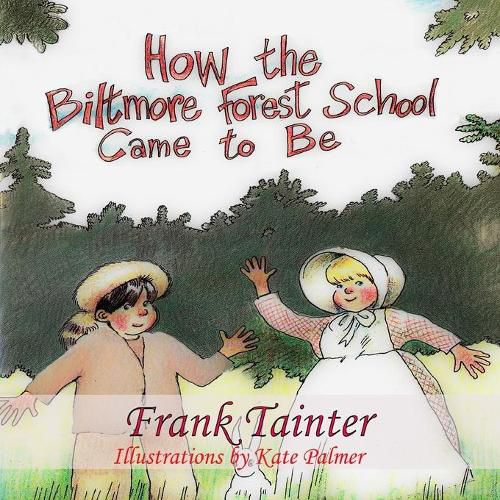Readings Newsletter
Become a Readings Member to make your shopping experience even easier.
Sign in or sign up for free!
You’re not far away from qualifying for FREE standard shipping within Australia
You’ve qualified for FREE standard shipping within Australia
The cart is loading…






This title is printed to order. This book may have been self-published. If so, we cannot guarantee the quality of the content. In the main most books will have gone through the editing process however some may not. We therefore suggest that you be aware of this before ordering this book. If in doubt check either the author or publisher’s details as we are unable to accept any returns unless they are faulty. Please contact us if you have any questions.
This coloring booklet answers the question of, How the Biltmore Forest School Come to Be. You might ask the question, WHY did the Biltmore Forest School come to be ?
The following answer will help provide an understanding of the greatest conservation challenge of America’s history.
Until the end of the 19th century, forestry in America was primarily a cut out and get out operation. But, as the 1800s came to a close, land owners, and the forest industry, realized that the endless forests they were cutting were not so endless after all. Most of the forests in the Northeast had been cut much earlier for the production of charcoal, forests in the Midwest were cut to provide housing for the settlers going west, and much of the Southeast had been cut down a century earlier to provide land for planting of cotton. What remained of our supposedly endless forests were being rapidly harvested, and not being replaced. That the end was in sight became especially obvious to the timber harvesters in the Pacific Northwest when they arrived at the Pacific Ocean.
So, what could be done? It soon became apparent that the recently developed European forestry methods were not applicable in America. Conservation leaders like Gifford Pinchot, Theodore Roosevelt and John Muir began to make the public aware of the dangers awaiting our country if all the forests were not managed properly for sustained productivity. A German forester named Carl Alwin Schenck was hired by a very wealthy man, George Vanderbilt, in 1895, to place his cutover property under management for the sustained production of wood. Vanderbilt’s land holdings soon grew to 120,000 acres and Schenck had his work cut out for him. Schenck hired young men to help him manage the property and because the men had so many questions, Schenck gave lectures explaining why he did things a certain way. This soon attracted more men who wanted to learn about forest management and the Biltmore Forest School was formed. It was the first forestry school in the United States and operated for nearly two decades. It’s story is summarized in this coloring booklet.
$9.00 standard shipping within Australia
FREE standard shipping within Australia for orders over $100.00
Express & International shipping calculated at checkout
Stock availability can be subject to change without notice. We recommend calling the shop or contacting our online team to check availability of low stock items. Please see our Shopping Online page for more details.
This title is printed to order. This book may have been self-published. If so, we cannot guarantee the quality of the content. In the main most books will have gone through the editing process however some may not. We therefore suggest that you be aware of this before ordering this book. If in doubt check either the author or publisher’s details as we are unable to accept any returns unless they are faulty. Please contact us if you have any questions.
This coloring booklet answers the question of, How the Biltmore Forest School Come to Be. You might ask the question, WHY did the Biltmore Forest School come to be ?
The following answer will help provide an understanding of the greatest conservation challenge of America’s history.
Until the end of the 19th century, forestry in America was primarily a cut out and get out operation. But, as the 1800s came to a close, land owners, and the forest industry, realized that the endless forests they were cutting were not so endless after all. Most of the forests in the Northeast had been cut much earlier for the production of charcoal, forests in the Midwest were cut to provide housing for the settlers going west, and much of the Southeast had been cut down a century earlier to provide land for planting of cotton. What remained of our supposedly endless forests were being rapidly harvested, and not being replaced. That the end was in sight became especially obvious to the timber harvesters in the Pacific Northwest when they arrived at the Pacific Ocean.
So, what could be done? It soon became apparent that the recently developed European forestry methods were not applicable in America. Conservation leaders like Gifford Pinchot, Theodore Roosevelt and John Muir began to make the public aware of the dangers awaiting our country if all the forests were not managed properly for sustained productivity. A German forester named Carl Alwin Schenck was hired by a very wealthy man, George Vanderbilt, in 1895, to place his cutover property under management for the sustained production of wood. Vanderbilt’s land holdings soon grew to 120,000 acres and Schenck had his work cut out for him. Schenck hired young men to help him manage the property and because the men had so many questions, Schenck gave lectures explaining why he did things a certain way. This soon attracted more men who wanted to learn about forest management and the Biltmore Forest School was formed. It was the first forestry school in the United States and operated for nearly two decades. It’s story is summarized in this coloring booklet.